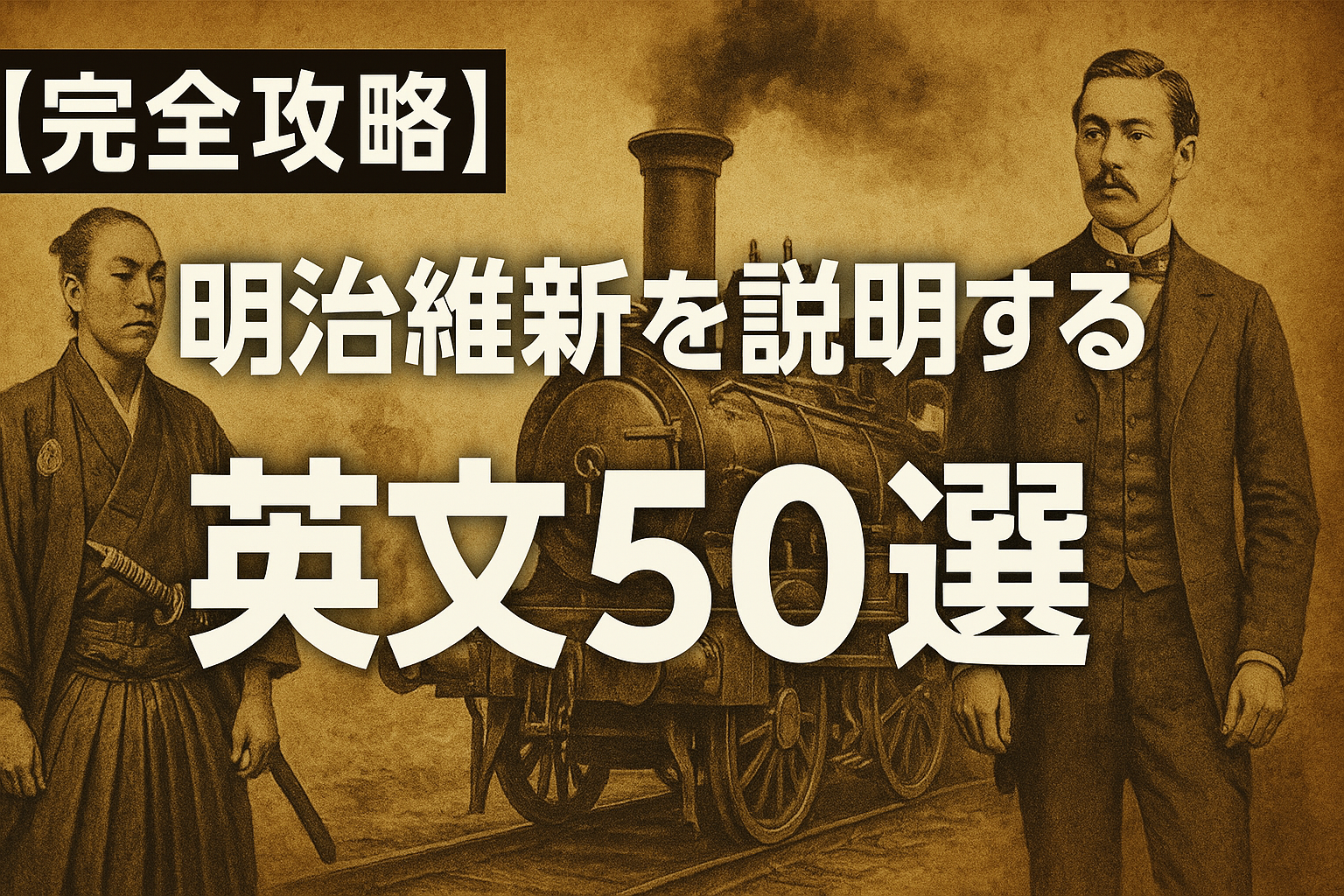今回は明治維新を説明する英文50選を、時系列・テーマ別に整理してお届けします。
海外の友人や同僚から「明治維新って何?」「なぜ日本は急速に近代化したの?」「どんな変化があったの?」と聞かれた時、うまく説明できる自信はありますか?
そんな悩みを一気に解決します!
サクッと確認してみましょう!
明治維新と英語表現の基礎知識
まず理解しておきたいのは、明治維新は封建制から近代国家への劇的変革であり、日本が西洋に追いつくための包括的改革だったということです。
基本的な明治維新用語
| 日本語 | 英語 |
|---|---|
| 明治維新 | Meiji Restoration |
| 王政復古 | Imperial Restoration |
| 廃藩置県 | Abolition of feudal domains |
| 文明開化 | Bunmei Kaika / Civilization and Enlightenment |
| 富国強兵 | Fukoku Kyohei / Enrich country, strengthen military |
| 殖産興業 | Shokusan Kogyo / Industrial promotion |
| 開国 | Opening of the country |
| 尊王攘夷 | Revere the Emperor, expel the barbarians |
明治維新説明英文50選
背景と原因(10文)
1853-1868年:危機と変革の序章
1. 江戸幕府の危機
- “The Meiji Restoration (1868) marked the end of Japan’s feudal Tokugawa shogunate that had ruled for over 250 years.” (明治維新(1868年)は250年以上統治していた日本の封建的徳川幕府の終わりを示しました。)
- “Growing internal problems and external pressure from Western powers weakened the Tokugawa government’s authority.” (内政問題の増大と西洋列強からの外圧が徳川政府の権威を弱体化させました。)
- “Commodore Perry’s arrival in 1853 with ‘Black Ships’ forced Japan to end its isolationist policy.” (1853年のペリー提督の「黒船」来航は日本に鎖国政策の終了を迫りました。)
- “The unequal treaties imposed by Western nations humiliated Japan and sparked domestic opposition.” (西洋諸国により押し付けられた不平等条約は日本を屈辱し、国内反対を引き起こしました。)
- “Economic difficulties, natural disasters, and social unrest created widespread dissatisfaction with Tokugawa rule.” (経済困難、自然災害、社会不安が徳川統治に対する広範な不満を生み出しました。)
2. 政治的変化の始まり
- “The slogan ‘Sonno Joi’ (Revere the Emperor, Expel the Barbarians) rallied opposition against the shogunate.” (「尊王攘夷」のスローガンが幕府に対する反対を結集させました。)
- “Powerful domains like Satsuma and Choshu formed an alliance to overthrow the Tokugawa regime.” (薩摩や長州などの強力な藩が徳川政権を打倒するための同盟を形成しました。)
- “The Boshin War (1868-1869) was the civil conflict that resulted in the shogunate’s defeat.” (戊辰戦争(1868-1869年)は幕府の敗北をもたらした内戦でした。)
- “Emperor Meiji’s restoration to power represented a return to imperial rule after centuries of military government.” (明治天皇の権力復帰は何世紀もの軍事政権の後の帝政復帰を表しました。)
- “The Charter Oath of 1868 outlined the new government’s commitment to modernization and reform.” (1868年の五箇条の御誓文は新政府の近代化と改革への決意を概説しました。)
政治・行政改革(10文)
1868-1885年:政治制度の近代化
3. 中央集権化
- “The abolition of the feudal han system in 1871 replaced autonomous domains with centrally controlled prefectures.” (1871年の廃藩置県は自治的な藩を中央統制の県に置き換えました。)
- “Former daimyo lords were given government positions and pensions in exchange for surrendering their territories.” (元大名は領地を放棄する代わりに政府の地位と年金を与えられました。)
- “A new centralized bureaucracy was established to implement nationwide policies and reforms.” (全国的政策と改革を実施するために新しい中央集権官僚制が確立されました。)
- “The Meiji Constitution of 1889 created a constitutional monarchy with the Emperor as head of state.” (1889年の明治憲法は天皇を国家元首とする立憲君主制を創設しました。)
- “A modern legal system based on Western models was introduced to replace traditional feudal laws.” (西洋モデルに基づく近代的法制度が伝統的封建法に代わって導入されました。)
4. 社会制度改革
- “The rigid four-class system of samurai, farmers, artisans, and merchants was officially abolished.” (武士、農民、職人、商人の厳格な四民制度が正式に廃止されました。)
- “All citizens gained legal equality and freedom of movement, ending centuries of social stratification.” (すべての市民が法的平等と移動の自由を得て、何世紀もの社会階層制が終了しました。)
- “The samurai class lost their exclusive privileges and were prohibited from carrying swords.” (武士階級は独占的特権を失い、刀の携帯を禁止されました。)
- “Land ownership was reformed, allowing farmers to own and sell their land freely.” (土地所有制度が改革され、農民が自由に土地を所有し売買することが可能になりました。)
- “Military conscription was introduced, requiring all men to serve in the national army.” (徴兵制が導入され、すべての男性が国軍での服務を義務づけられました。)
経済・産業改革(10文)
1870-1890年:産業の推進
5. 産業近代化
- “The Meiji government promoted ‘Fukoku Kyohei’ (Rich Country, Strong Military) as its national goal.” (明治政府は「富国強兵」を国家目標として推進しました。)
- “State-led industrialization focused on developing strategic industries like steel, textiles, and shipbuilding.” (国家主導の工業化は鉄鋼、繊維、造船などの戦略産業の発展に焦点を当てました。)
- “The government established model factories and invited Western experts to transfer technology.” (政府は模範工場を設立し、技術移転のために西洋の専門家を招聘しました。)
- “Railway construction connected major cities and facilitated the movement of people and goods.” (鉄道建設が主要都市を結び、人と物の移動を促進しました。)
- “The zaibatsu system of industrial conglomerates emerged to drive economic development.” (経済発展を推進するため財閥制度の産業コングロマリットが出現しました。)
6. 金融・通貨制度
- “A modern banking system was established with the Bank of Japan as the central bank.” (日本銀行を中央銀行とする近代的銀行制度が確立されました。)
- “Standardized currency replaced the complex system of feudal domain currencies.” (標準化通貨が複雑な藩通貨制度に取って代わりました。)
- “Government bonds were issued to finance infrastructure projects and military expansion.” (インフラ事業と軍事拡張の資金調達のために国債が発行されました。)
- “Foreign trade expanded rapidly as Japan opened new markets for its products.” (日本が製品の新市場を開拓するにつれて対外貿易が急速に拡大しました。)
- “Tax reforms shifted from payment in rice to monetary taxes, modernizing the fiscal system.” (税制改革は米での支払いから金銭税に移行し、財政制度を近代化しました。)
社会・文化変革(10文)
1872-1900年:文明開化の時代
7. 教育制度
- “The Education System Order of 1872 established compulsory elementary education for all children.” (1872年の学制は全ての子どもに義務初等教育を確立しました。)
- “Western-style schools and universities were built to train a modern, educated workforce.” (近代的で教育を受けた労働力を訓練するために西洋式学校と大学が建設されました。)
- “Thousands of Japanese students were sent abroad to study Western science and technology.” (何千人もの日本人学生が西洋の科学技術を学ぶために海外に派遣されました。)
- “Foreign teachers and advisors were hired to help modernize Japan’s educational system.” (日本の教育制度の近代化を支援するため外国人教師と顧問が雇用されました。)
- “Literacy rates improved dramatically as education became more accessible to the general population.” (教育が一般民衆により利用しやすくなるにつれて識字率が劇的に向上しました。)
8. 文明開化
- “Bunmei Kaika (Civilization and Enlightenment) promoted the adoption of Western customs and technology.” (文明開化は西洋の習慣と技術の採用を推進しました。)
- “Western clothing, architecture, and lifestyle gradually replaced traditional Japanese practices.” (西洋の衣服、建築、ライフスタイルが徐々に日本の伝統的慣行に取って代わりました。)
- “The introduction of gas lighting, telegraph systems, and railways transformed daily life.” (ガス灯、電信システム、鉄道の導入が日常生活を変革しました。)
- “Western medical knowledge and practices were adopted to improve public health.” (公衆衛生を改善するため西洋の医学知識と実践が採用されました。)
- “The Gregorian calendar was adopted in 1873, replacing the traditional lunar calendar.” (1873年にグレゴリオ暦が採用され、伝統的な太陰暦に取って代わりました。)
国際関係と結果(10文)
1890-1912年:世界大国への道
9. 対外政策
- “Japan’s rapid modernization aimed to avoid colonization and achieve equality with Western powers.” (日本の急速な近代化は植民地化を避け、西洋列強との平等達成を目指しました。)
- “The unequal treaties were gradually revised as Japan demonstrated its modernization progress.” (日本が近代化の進歩を実証するにつれて不平等条約は徐々に改正されました。)
- “Military victories against China (1894-95) and Russia (1904-05) established Japan as a regional power.” (中国(1894-95年)とロシア(1904-05年)に対する軍事的勝利が日本を地域大国として確立しました。)
- “Korea was annexed in 1910 as Japan began its imperial expansion.” (日本が帝国主義的拡張を始めるにつれて1910年に朝鮮が併合されました。)
- “Japan’s success inspired other Asian nations to pursue their own modernization efforts.” (日本の成功は他のアジア諸国に独自の近代化努力を追求するよう刺激しました。)
10. 長期的影響
- “The Meiji Restoration transformed Japan from a feudal society into a modern industrial nation within decades.” (明治維新は数十年以内に日本を封建社会から近代工業国家に変革しました。)
- “Rapid modernization created social tensions between traditional values and Western influences.” (急速な近代化は伝統的価値と西洋の影響の間で社会的緊張を生み出しました。)
- “The foundation laid during the Meiji period enabled Japan’s emergence as a world power.” (明治期に築かれた基盤が日本の世界大国としての台頭を可能にしました。)
- “Japan’s unique approach of selective modernization preserved cultural identity while embracing change.” (選択的近代化という日本独特のアプローチは変化を受け入れながら文化的アイデンティティを保持しました。)
- “The Meiji Restoration serves as a model for successful national transformation and modernization.” (明治維新は成功した国家変革と近代化のモデルとして機能します。)
おわりに
いかがでしたか?
明治維新は日本史上最も重要な変革期の一つです。ぜひ、適切な英語表現でその歴史的意義を世界に発信してくださいね!
それでは!




コメント